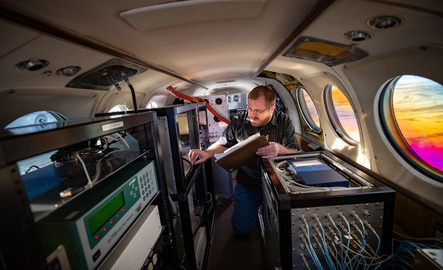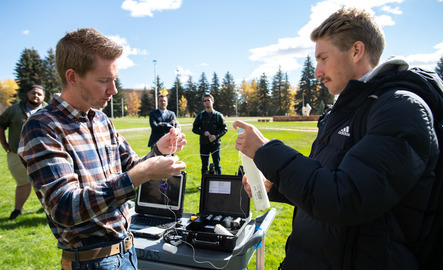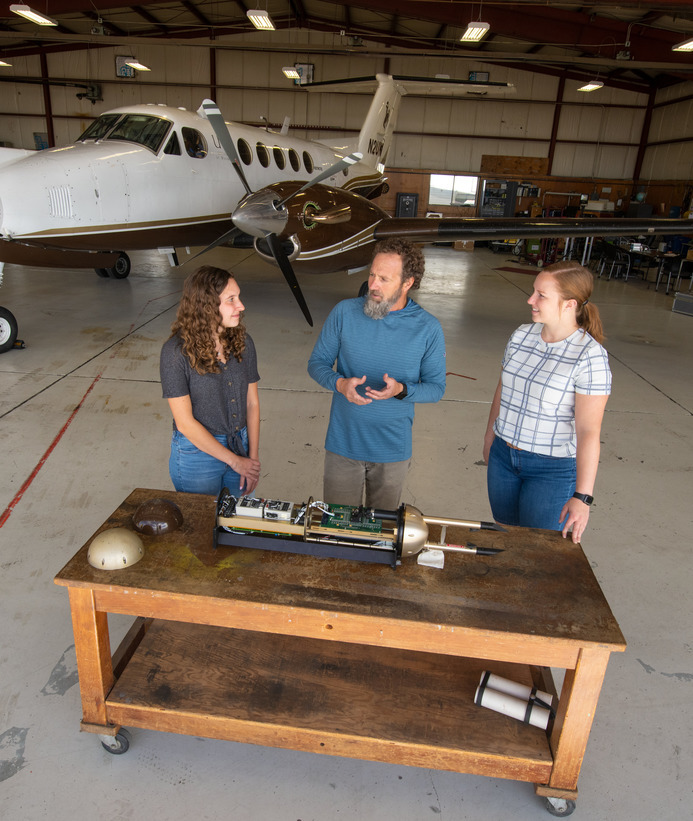About Atmospheric Science at UW
Since its inception in 1965, airborne research at UW has flourished, creating an extraordinary program under the Department of Atmospheric Science that continues to thrive to this day. Supported by a team of highly qualified faculty, state-of-the-art facilities and cutting-edge research, students enrolled in our atmospheric graduate programs are getting a one-of-a-kind education.
Students can enter the atmospheric science program in 3 ways:
- Master's (M.S.)
- Dual M.S. + Ph.D.
- Ph.D. only
Most students start in the M.S. program. Those planning to continue to a Ph.D. are considered "Ph.D.-bound" and should register as a dual-degree student. This dual-degree status can be assigned at admission or after students prove their academic and research ability, with approval from their advisor or Department Head. Students who already hold a thesis-based M.S. in atmospheric science or a related field usually enter into the Ph.D. program. Exceptionally strong students without a master's may also be directly admitted to the Ph.D., but they are encouraged to complete a master's along the way.

Take a glance at what your journey as an atmospheric science student could look like!
Our graduate students have access to top-notch resources and research experiences, setting our atmospheric science degrees apart as one of the best in the country. Students will collaborate with a major professor specializing in one of the diverse research areas within the department.
Learn More
At UW, we offer courses that cover core atmospheric science topics along with numerous electives to allow our graduate students to dive deep into their interests. Here are just some classes you might take getting your atmospheric science degree at UW:
- Dynamic Meteorology
- Synoptic Meteorology
- Objective Data Analysis
- Climate Science
- Weather Analysis & Forecasting
Our M.S. requires 30 hours, including 26 coursework hours and 4 thesis research hours. Students complete 20 core course hours and 6 elective hours chosen with their advisor's guidance. View the full master of science in atmospheric science degree program curriculum and requirements.
Our Ph.D. requires 72 total hours, with at least 42 hours of coursework. Up to 48, including 4 thesis research hours, can be transferred from another institution. View the full Ph.D. in atmospheric science degree program curriculum and requirements.

What Can You Do With an Atmospheric Science Graduate Degree?
The results speak for themselves - graduates of our programs emerge well-prepared, stepping confidently into successful careers in atmospheric science and other technical fields ranging from academic faculty and leading government scientists to founders of their own companies. Their achievements stand as a powerful testament to the program's transformative impact.
- Air and Water Quality Manager
- Climatologist
- Climate Scientist
- Meteorologist
- Professor
- Storm Specialist
- Weather Forecaster
- Weather Risk Communicator
The job outlook for atmospheric science grads is generally positive, as the need for innovation and a deeper understanding in our field continues to grow. Opportunities span government, research, media and private sectors.
Generally, most atmospheric science graduates work in the public sector, especially at agencies like NOAA, NASA and the National Weather Service. However, there's growing demand in the private sector, including consulting firms, media and tech companies.
Yes, atmospheric science grads are definitely in demand in renewable energy and sustainability. Weather forecasting and climate modeling skills are vital to support wind and solar energy, environmental planning and climate risk assessment.
Research in our program is structured but flexible. From early on, you're working with your advisor to define a project, you formally document it through a Research Plan, then you carry it out under committee oversight, culminating in a public defense.
For M.S. Students:
- Research begins in the first semester. You'll have early meetings with your advisor to define your thesis objectives.
- You must present your research objectives in the course ATSC 5018: Research Methods & Ethics.
- By the end of the second semester, you should have your thesis committee appointed.
- Before or during the third semester, you'll prepare a Research Plan. This plan includes background/literature, preliminary results (if any), the work you will do and a timeline.
- Once the Research Plan is approved and your Program of Study is in place, you become a "Candidate." Then through the third and fourth semesters, you'll execute the research and write your thesis.
- The thesis defense is a public presentation and a Q&A with your committee. Ideally, this happens by the end of your fourth semester.
For Ph.D. Students:
- You must demonstrate proficiency in core courses (grade B or better) before or during your Ph.D. research.
- Form your Ph.D. committee soon after admission.
- Prepare and defend a Ph.D. Research Plan (which also serves as the Preliminary Exam)
no later than:
- Second semester if continuing M.S. research line, or
- Fourth semester if switching research lines.
- The Research Plan must show uniqueness and relevance of your project, background, preliminary results, timeline, etc.
- After plan approval, you proceed as a Ph.D. candidate and carry out the work and write out your dissertation (often submitting papers to peer-review journals along the way).
- The dissertation defense ideally is completed by the end of your fifth year at UW.
The ATSC Research Plan is a concise proposal outlining the research a student will carry out for their M.S. thesis or Ph.D. dissertation. It includes:
- Background and significance of the research topic.
- Scope of the project, showing both work already completed and work still to be done.
- Preliminary results, such as early findings or conference presentations.
- Planned work and a timeline for completing it.
- Formatting Requirements:
- M.S. students: 8-10 pages (maximum 15)
- Ph.D. students: maximum 15 pages
- Must follow NSF proposal style (figures allowed, references excluded from page limit)
Driving Innovation at UW
Joining UW’s atmospheric science graduate program sets you on the path to become a leader in weather, climate and air quality innovation. With hands-on access to a research aircraft and a world-class supercomputer, you’ll gain cutting-edge skills to shape the future of atmospheric science. Our grads go on to thrive in their roles and make a lasting impact for Wyoming and beyond!


